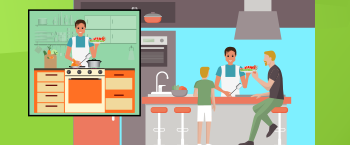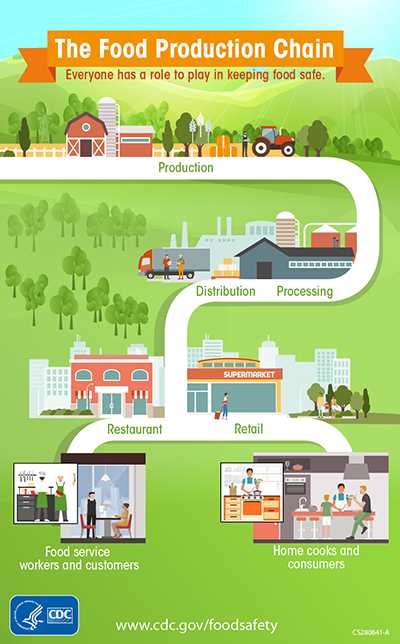How Food Gets Contaminated - The Food Production Chain
On This Page
It takes several steps to get food from the farm or fishery to the dining table. We call these steps the food production chain (see graphic). Contamination can occur at any point along the chain—during production, processing, distribution, or preparation.
Production
Production means growing the plants we harvest or raising the animals we use for food. Most food comes from domesticated animals and plants, and their production occurs on farms or ranches. Some foods are caught or harvested from the wild, such as some fish, mushrooms, and game.

Production means growing the plants we harvest or raising the animals we use for food.
Examples of Contamination in Production
- If a hen’s reproductive organs are infected, the yolk of an egg can be contaminated in the hen before it is even laid.
- If the fields are sprayed with contaminated water for irrigation, fruits and vegetables can be contaminated before harvest.
- Fish in some tropical reefs may acquire a toxin from the smaller sea creatures they eat.
Processing
Processing means changing plants or animals into what we recognize and buy as food. Processing involves different steps for different kinds of foods. For produce, processing can be as simple as washing and sorting, or it can involve trimming, slicing, or shredding. Milk is usually processed by pasteurizing it; sometimes it is made into cheese. Nuts may be roasted, chopped, or ground (such as with peanut butter). For animals, the first step of processing is slaughter. Meat and poultry may then be cut into pieces or ground. They may also be smoked, cooked, or frozen and may be combined with other ingredients to make a sausage or entrée, such as a potpie.

Processing means changing plants or animals into what we recognize and buy as food.
Examples of Contamination in Processing
- If contaminated water or ice is used to wash, pack, or chill fruits or vegetables, the contamination can spread to those items.
- During the slaughter process, germs on an animal’s hide that came from the intestines can get into the final meat product.
- If germs contaminate surfaces used for food processing, such as a processing line or storage bins, germs can spread to foods that touch those surfaces.
Distribution
Distribution means getting food from the farm or processing plant to the consumer or a food service facility like a restaurant, cafeteria, or hospital kitchen. This step might involve transporting foods just once, such as trucking produce from a farm to the local farmers’ market. Or it might involve many stages. For instance, frozen hamburger patties might be trucked from a meat processing plant to a large supplier, stored for a few days in the supplier’s warehouse, trucked again to a local distribution facility for a restaurant chain, and finally delivered to an individual restaurant.

Distribution means getting food from the farm or processing plant to the consumer or a food service facility like a restaurant, cafeteria, or hospital kitchen.
Examples of Contamination in Distribution
- If refrigerated food is left on a loading dock for long time in warm weather, it could reach temperatures that allow bacteria to grow.
- Fresh produce can be contaminated if it is loaded into a truck that was not cleaned after transporting animals or animal products.
Preparation
Preparation means getting the food ready to eat. This step may occur in the kitchen of a restaurant, home, or institution. It may involve following a complex recipe with many ingredients, simply heating and serving a food on a plate, or just opening a package and eating the food.

Preparation means getting the food ready to eat. This step may occur in the kitchen of a restaurant, home, or institution.
Examples of Contamination in Preparation
- If a food worker stays on the job while sick and does not wash his or her hands carefully after using the toilet, the food worker can spread germs by touching food.
- If a cook uses a cutting board or knife to cut raw chicken and then uses the same knife or cutting board without washing it to slice tomatoes for a salad, the tomatoes can be contaminated by germs from the chicken.
- Contamination can occur in a refrigerator if meat juices get on items that will be eaten raw.
Mishandling at Multiple Points
Sometimes, by the time a food causes illness, it has been mishandled in several ways along the food production chain. Once contamination occurs, further mishandling, such as undercooking the food or leaving it out on the counter at an unsafe temperature, can make a foodborne illness more likely. Many germs grow quickly in food held at room temperature; a tiny number can grow to a large number in just a few hours. Reheating or boiling food after it has been left at room temperature for a long time does not always make it safe because some germs produce toxins that are not destroyed by heat.
Related Pages
- Page last reviewed: September 5, 2017
- Page last updated: September 5, 2017
- Content source:


 ShareCompartir
ShareCompartir
